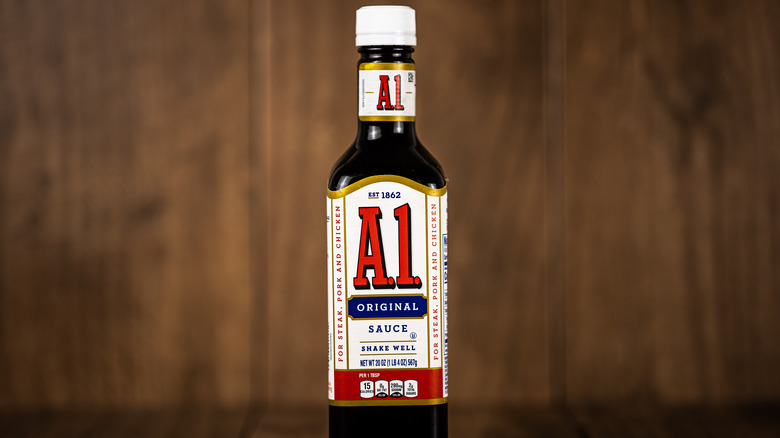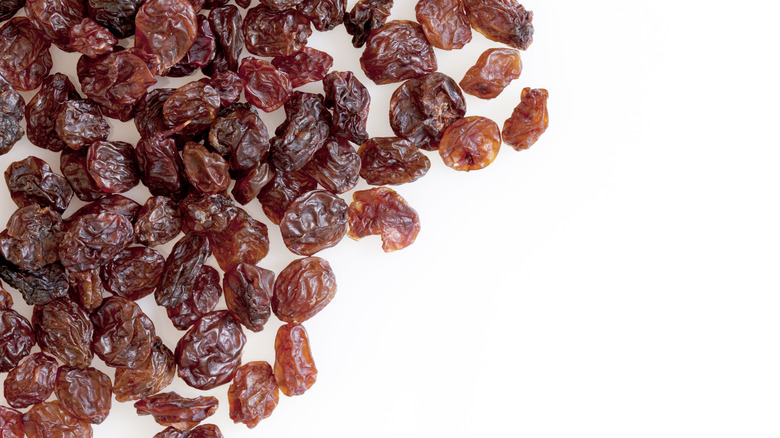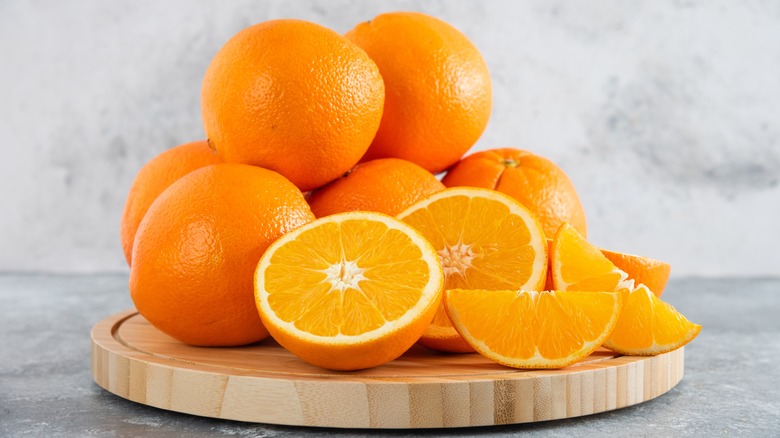The Fruits That Give A.1. Sauce That Extra Punch Of Flavor
A.1. Sauce is easily one of my favorite condiments of all time. It hits the flavor range between salty, tangy, and sweet, and because of this, it makes for a remarkably good pairing with a rich cut of steak. Admittedly, you'll usually pay a premium for it at the grocery store, but despite that fact, I've always got a bottle sitting in my refrigerator.
A.1. was invented in (or around — the specific date is unclear) 1824 by Henderson William Brand, who was a chef to the United Kingdom's King George IV. Its ingredient list includes tomato puree, vinegar, corn syrup, salt, raisin paste, crushed orange puree, spice, dried garlic, caramel color, dried onions, and celery seed.
What's particularly of note is the inclusion of fruit, namely raisins and crushed oranges. After all, you'd imagine a steak sauce to mainly be comprised of ingredients that are savory and vegetal, rather than ones we consider sweet. That's why it's worth examining just why and how these two fruits make sense in the scheme of A.1. — and just how they contribute to the sauce's signature flavor.
What raisins contribute to A.1. Sauce
Raisins, aka good old dried grapes, have a concentrated sugary taste that can be slightly tart as well. Notably, another fruit with a similar profile, tamarind (which is often used in sweet and tangy candies), is a key ingredient in another condiment we closely associate with steaks, Worcestershire sauce.
Because tamarind carries such a complex flavor, it's easily able to cross boundaries between savory and sweet applications. In this case, raisins function similarly, but with a much more subtle tang. It's also thought that the antioxidants in raisin paste might have slowed beef from spoiling as quickly in the absence of refrigeration.
Grapes also contain naturally occurring glutamates. Glutamates trigger the flavor sensation you know as umami, or savoriness, which is why their presence amplifies savoriness in other foods that are also naturally high in them, such as red meat. Though we associate it mainly with steak, A.1. Sauce does claim to be all-purpose, which means you can try using it with other types of meat or vegetables to contribute to their savoriness, thanks to that handy glutamic boost (I like using it with mushrooms, if you need a starting point for experimentation).
Oranges add a bright aroma and some acid
The other fruit listed in A.1. Sauce's ingredients list is oranges, in the form of crushed orange puree. In the sauce, the orange flavor isn't easy to detect (if at all), but the essential oil in citrus fruit adds to the sauce's aroma, plus its natural acidity adds to its overall tangy flavor.
The original oranges used in A.1.'s recipe were Seville oranges, which are bitter and sour. At one point the sauce's orange content was supplied by orange marmalade, but that's since changed into the current crushed orange puree. What's also worth noting is that A.1.'s recipe changes depending on what country you're in; Canada's formulation for the condiment contains concentrated orange juice and not the puree we have in the United States.
All of this being said, A.1. Sauce is vegan, even though its association with grilled meat is anything but. The brand dropped the word "steak" from its former name (A.1. Steak Sauce) in 2014 to try and give it a wider appeal. But however you choose to use it, A.1. definitely packs a ton of flavor, and in part with the help of two types of fruit that do a lot of heavy lifting.


